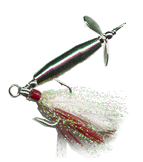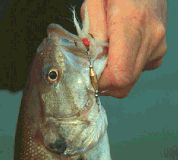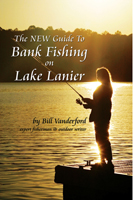April
is a time of Rebirth and Farewell at Lake Lanier
By
Bill Vanderford
Spring has finally come to Lake Lanier, and the shorelines
are ablaze with colors from the dogwoods, mountain laurel, rhododendron,
and wild azaleas. Sediments deposited from rains mix with the constantly
falling pollen to give the lake water a greener color. Surface temperatures
are rising above 60 degrees Fahrenheit for the first time, and the
spotted bass population has turned its interest to food and making
love!

Photo by Bill Vanderford
|
The only sad part of the spring season is that the beautiful loons
that have been here throughout the winter months will soon disappear
until next fall. With the possible exception of bird watchers, it wasn't
until the movie, "On Golden Pond", that most people ever
noticed loons, and up until a few years ago, none were seen in our
area. For some unknown reason, however, these mysterious visitors from
the North start showing up around mid November and remain until late
April.
For those unfamiliar with this magnificent waterfowl, some facts are
in order. The common loon can fly nearly sixty miles per hour, swim
faster than most fish, can remain under water easily for five to ten
minutes, and their haunting song penetrates the morning fog on Lake
Lanier like the beam of a powerful searchlight!
As always, it will be a sad morning when I go out on Lake Lanier one
day soon and don't hear that high-pitched, lonely song that has
warmed my heart throughout this past winter and early spring. Nevertheless,
I know that summer's madness of boats and mass humanity will
pass, and that when the lake again welcomes the cool breezes of late
fall, the loons and sanity will again return to Lake Lanier.

 Spotted bass, however, have already begun their spawning cycle, and
are becoming more aggressive every day. One "sure-fire" method
to catch big numbers of these one to five pound bass during this period
requires the use of a tiny lure that closely resembles smaller shad
minnows.
Spotted bass, however, have already begun their spawning cycle, and
are becoming more aggressive every day. One "sure-fire" method
to catch big numbers of these one to five pound bass during this period
requires the use of a tiny lure that closely resembles smaller shad
minnows.
This is accomplished by employing a small, inline spinner known as
the "Swirleybird". The perfect Swirleybird size for spotted
bass is 1/8th ounce, but quite a few anglers have downsized to the
new Fly rod-sized Swirleybird for increased strikes and to be more
sporting. These diminutive lures can only cast with a fly rod or ultralight
spinning reel.
Though one may catch bass just by casting and reeling with the Swirleybird,
learning the proper method will guarantee success throughout the next
two months. However, one must learn to go against conventional bass
wisdom, especially in respect to the hook set. In fact, if the reaction
to a strike is treated with a hard, upward jerk to set the hook, most
spotted bass will be missed.
Success will come when one learns to tease the spotted bass by winding
the reel handle one quick revolution, followed by a continued slow
retrieve. This action pulls the bait away just enough to incite the
fish into taking in more of the tiny lure on its next pass. This sequence
could reoccur five or six times before the angry "spot" finally
tires of the game and inhales the tiny lure.
Regardless of one's
age, gender, or experience, these lures make it easy for anyone to
catch plenty of spotted bass during the spawn at Lake Lanier. In fact,
women and children with little or no fishing background are often far
more successful than seasoned bass anglers. These neophytes generally
listen to the instructions better, are not set in their ways, and don't
react violently to every strike. Also, they often use spincast reels
that possess a much slower retrieve, which keeps the lures in the strike
zone longer.
every strike. Also, they often use spincast reels
that possess a much slower retrieve, which keeps the lures in the strike
zone longer.
Also, the next couple of months is the best opportunity for those
who don't have boats to be successful fishing from the shoreline.
The experience can be greatly enhanced by purchasing a copy of the
new book, The New Guide to Bank Fishing on Lake Lanier, which is available
at www.georgiafishing.com.
Though the loons are leaving, Lake Lanier would have to be considered
one of the hottest prospects in the South for spotted bass during the
spawning period. So, use these keys and a few Swirleybirds to open
the door to some of the most exciting spring bassin' anywhere!
SIDEBAR: Swirleybirds and excellent fishing guide service is available
by visiting www.lanierfishing.com or by calling 678-367-0012.
Bill Vanderford has won numerous awards for his writing and photography,
and has been inducted into the National Freshwater Fishing Hall of
Fame as a Legendary Guide. He can be reached at 770-289-1543, at JFish51@aol.com,
or at his web site: www.fishinglanier.com

